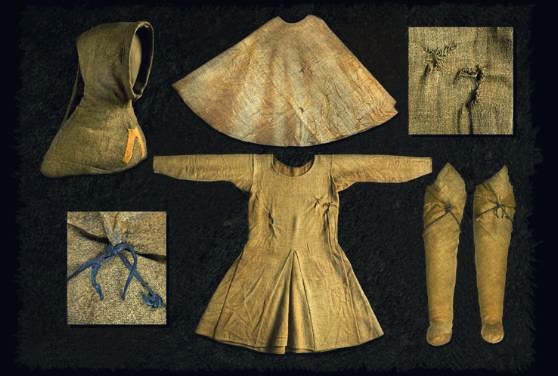Bockstensmannen: one of the most famous medieval bodies ever found, but how did it happen?
It is truly wonderful to find archeological artifacts, both when you are looking for them, but especially when you find them without intention.
It is called serendipity when you find something by accident, and there sure is something special when you find something in nature by mistake. It is hidden there for the world with no intention to be found, living in its own universe of dirt, green leaves, and vegetation. When you are walking your forest path and see something between the trees and you decide to investigate, just to come home bubbly happy for finding an old house foundation or a left-over military base.
Or even better, those very rare occasions when something is glimmering in the ground that catches your eye. You bend over to take a closer look and find out it is a treasure from times long lost, safely tucked into a tuft of grass. It has been hidden for centuries, only for you to find it again.
Yes, it is probably the same feeling Sméagol felt when he found the one and only ring, but hopefully without the afterbirth of a pinch of craziness to say the least.
So yes, it is an amazing feeling to find something, and it is truly a surprise when you find them without being prepared.
But there are occasions when the surprise is… well, quite not really the joyful situation described above. Especially not If you are eleven years of age and a dead body gets stuck in your plow out in the middle of a bog.
What is stuck in my plow?
Who am I talking about? Well, Bockstensmannen of course! Oh, sorry! You meant the little boy? His name was Thure Johansson and the day of the find was the day before midsummer, the 22: nd of June 1936 in Åkulla, east of Varberg in Hallands parish, Sweden. Thure was sent out by his father to the Bocksten bog to harrow peat together with his little sister.
So, it was doing this when Thure noticed something that looked like a rag was stuck in his plow. He immediately stopped his horse to investigate and what he found he described as a bag with bones inside. He run to fetch his dad who was working in the barn about 50 meters away. Together they continued the investigation and what they found was more fabric. And bones. And a skull. They first thought they had found a murdered person, and well, they were not completely off track, only 650 years later.
So, they covered up the body out of respect, and the next day, they called the police and a doctor who came out to look at the body. They could confirm that the body, who laid headlong in the bog, was not a recent murder. The body had been pierced with piles; one in the heart that was still intact, one that had pierced the body mid back, and then the third one that had been attempted to pierce the body at the hips, but the hipbone were too strong to be broken, only leaving marks on the clothes.

Time to be buried on holy ground
The police decided to call the vicar and told him that they had found a dead body and that a burial on holy ground would be suitable for the situation. The vicar decided that the burial would be held the next coming Sunday. The policeman and the doctor left the site, happy after a good day’s work and with a new souvenir in the form of a foot from the dead man. This was of course something we are happy did not happen, and the reason why is just as random as finding the man in the bog.
The museum director for the Museum of Halland was by coincidence running into the doctor who had examined the body one day later, on the evening of midsummer’s eve. The doctor told the museum director about the body and drew him a picture of what one of the garments looked like. What the director noticed right away, was that the garment looked like the ones used during the middle ages.
Change of plans by coincidence
The director, intrigued of course, went to the bog on midsummer’s day together with a professor and his assistant, a lieutenant, and a fabricant (quite a posse) to see the body. For the young boy, Thure, was this very exciting, mainly because he had never seen so many cars before at the same time.
They could ascertain that the body and the clothes indeed belonged to an individual who lived during the middle ages. Procedures were done, pictures were taken, and the body was carefully removed and transported to the museum.
How to handle a body and the janitor’s new job
The museum director, who was not very used to this, asked around in the professional field how to deal with a find like this. And to be fair, it is not every day you find out about a spiked medieval man in a bog by randomly talking to an old friend and manages to save the body from being buried anew.
He got a lot of information on how to preserve the items, for example the clothing needed to be kept moist so they did not dry out. The janitor got a new task to sprinkle water on them daily. The bones were examined, and the souvenir foot, well, the doctor and the policeman had to give it back. The preservation properties of the bog left some of the man’s soft parts still intact, as well as hair and nails. The brain was put in a jar together with parts of his skin, lung, liver, and also a piece of his upper lip, covered in mustache. The clothes were preserved, and the janitor was relieved from his moisturizing duties.
The man, who came to be called Bockstensmannen, after the bog he was found in, became, and still is today, the biggest attraction in the Museum of Halland. And no wonder, his clothes are the only preserved complete set of costumes from the middle ages.

But, the question still remains. Who was he?
It is believed he lived between 1350-1370 A.D. according to C-14. The dating of the findings is also accurate with the fashion of his clothes. The C-14 combined with an osteological analysis could also tell that Bockstensmannen was around 25 years of age when he died. He had curly hair, now dyed red of the bog’s acids. It was quite long, almost down to his shoulders, and his haircut was the trendiest style back then. He was about 172 cm tall and had small muscle attachments on his bones. This means he did not have a lot of muscles and therefore probably did not have heavy work which required, or created, muscles. He was well and probably even had a hint of a beer belly. And he drank beer. Lots of it according to his liver. But for all who know history, they did not really drink water back then, beer was the standard drink, for adults as well as children.
What about class?
This is the 14th century. Most of the population worked with their body. Only a few, like the aristocracy, did not have to work as hard with their bodies. So Bockstensmannen’s weak physic suggested he might belong to the higher classes of society. But here is the thing! The clothes he was wearing were made from Swedish wool, and the high society wore imported finer wool. Their servants were also dressed in this type of wool. So, he could not be an upper-class chap and not a servant to one either. Most likely, according to historian Eva Andersson, specializing in medieval clothes, he belonged to a lower craftsman family or was a servant at a burgess family.
Why did he die?
Well, now we have established where in society he might have belonged, and what he looked like. So, how did he die? Well, a theory is that he was murdered. His skull shows blunt trauma in the form of three blows to his head. The last one, in the back of his head, must have been the killing one, and he was probably already lying down.
But this is not the only theory. Some mean that the damages to the skull have a natural explanation; they occurred in the bog, years or even centuries after the man’s death. So, was he murdered or died of natural causes? We do not know.
But what about the piles?
Yes, that little detail. It is strange, no doubt about it. But, back in the day, one could use piles to spike a body in order to prevent it from coming back to haunt the living. This act does speak for the murderer theory – you would not want the one you just killed to haunt you. And he was pierced with not only one but two piles with an additional third attempt. Theories that he might have been a bailiff have been around for years, which can explain the murderer (someone did not want to hand out his cash), the lack of physical work, and the standard clothes. But, once again, this is just a theory.
Bockstensmannen gets a face.

Theories about who he was is many, and new ones are still popping up as research continues. But one thing that changed the image drastically about Bockstensmannen was back in 2006 when he got his face back. His skull was scanned and modelmaker, Oscar Nilsson, an expert in recreating faces according to the methodologies needed for this, created Bockstensmannen’s face. Now, a quite serious and determined young man will look back at you when you are visiting the museum. But there is no sign of his mustache.
So, Bockstensmannen is most definitely an interesting character who has created a lot of attention, and with good reasons. He and his clothes are the only still preserved complete medieval costume which draws people and researchers from close and afar to see him. Bockstensmannen’s story is still a mystery, even though it is slowly unraveled, little by little.
And what still remains is, that if Thure had not been lucky enough to find that pack of clothes on the summer’s day in 1936, Bockstensmannen would still lie in the bog until this day. So, stay curious, and make sure you tell people what you find, otherwise, your find might be put back into the soil again.
Photos: All: Hallands Museum. Copyright Hallands Museum.
Text: Lovisa Sénby Posse, 2020. Copyright 2020 Scandinavian Archaeology.
Further reading:
Bockstensmannen – ett unikt fynd
https://popularhistoria.se/vetenskap/arkeologi/vem-var-mannen-i-mossen
https://en.wikipedia.org/wiki/Bocksten_Man
About the author
Iron age Scandinavian archaeologist with a bachelor in Liberal arts with major in Archaeology and a bachelor in Art history with major in Nordic art, both from Uppsala University, Sweden. Exchange studies at Trinity College, Dublin, Ireland, and University of Pretoria, Pretoria, South Africa.
Master of Arts (two years) in Archaeology with specialization in burials, ship burials, and artefact management and interpretation, also from Uppsala university, Sweden.
In my master thesis I created an analyzing method to handle large quantities of artefacts, a method descended in Art History. I also created a method with elements of theory to perform a spatial analysis on graves. This also derived from Art History. The methods were applied to ship burials at Valsgärde, Upland, Sweden.
As Editor-in-chief, I am responsible for the publication and over all work with Scandinavian Archaeology, a job I deeply enjoy. I also founded the magazine in late September 2020.


